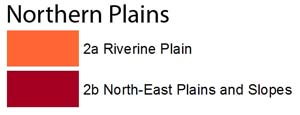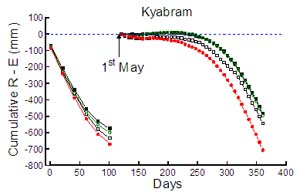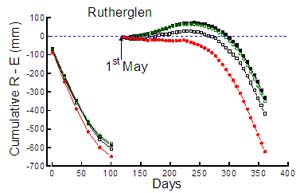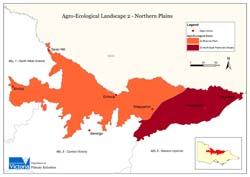Primary Production Landscapes Home
Land use
The Northern Plains comprises nearly 70% of Victoria’s irrigated agriculture (otherwise known as Victoria’s food bowl region). Dryland agriculture farming systems including mixed farming and dairy constitute 73% of regional land use (17% of Victoria’s dryland agriculture). The distribution of cropping to livestock production in mixed farming systems varies according to soil type and climatic factors. Mean annual rainfall varies from 350 mm in the north-west to 550 mm bordering the Central Uplands in the south. | |
Primary Production Landscapes
Riverine Plain
The plains have formed from alluvial processes leaving red sodic sands and clays with different agricultural potential than the cracking clay plains of the Wimmera and Mallee. Land use includes a diversity of mixed farming systems, irrigated horticulture and dairy.
North-East Plains and Slopes
Soils of variable depth occur across the plains and slopes where mixed farming (grazing and dryland cropping in long rotations) is the main land use. Vineyards and other horticulture pursuits also occur through the north-east. Rainfall is overall slightly higher than for the Riverine Plain. | |
| Management practices and issues in response to Climate Change
Mixed farming systems
- Dryland cropping practices have not altered extensively when compared with recent changes used in the Mallee and Wimmera. Uptake of no-till systems conserving available soil moisture for production is increasing.
- Grain growers are sowing crops earlier and dry to benefit from opportune rainfall events. The extended cropping operations window has allowed producers to maximise benefits derived from chemical and fertiliser applications.
- Cereals (especially barley) are preferred over grain legumes (including canola) due to recent crop failures and seasonal risks associated with growing legumes. Grain quality and protein content have improved while yields have declined. Continuous cropping has proven unsuccessful to date.
- In the North-East, more frequent cropping in mixed farming systems has occurred due to dry seasons and reduced impacts from waterlogging. A typical cropping rotation here is 3-4 years.
- Livestock production in mixed farming systems has been constrained by a shortage of available water while supplementary feeding has been an added expense to compensate for food shortages. Beef cattle production appears to be under pressure from pasture feed shortages that hamper fattening of livestock.
|
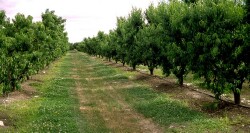
East Shepparton Orchard |
Dairy farming systems
- A marked shift from seasonal to mixed season calving has occurred in the last 20 years.
- An overall reduction in dairy cattle numbers has accelerated due to a shortage of water for fodder and grain production. This has resulted in reduced milk production in the region.
- Water scarcity (including decreased water entitlements) and rising cost of water has meant more complex feeding systems (feed rations) are required to support smaller holdings of livestock.
- Drier climate have dropped regional watertables and impacted upon access to water. Salinity doesn’t appear to be as severe due to this lowering of watertables.
- No significant change in disease status has been observed (although mastitis rates are down). There is a marked decrease in cow lameness which may be due to less waterlogging of pastures.
- Labour availability, aging labour population and access to labour with adequate skills are issues that continue to mount in dairy farming. Aging infrastructure including roads, transport and milk factories is a major concern for the dairy industry.
|
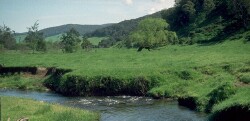
Tallangatta |
| Future scenarios for farming systems
Mixed farming systems
- Shift to water conservation farming systems including no-till farming and stubble management (retention).
- Integration of perennial pastures (including lucerne) and crops as part of an ‘integrated mixed farming system’ where wool that is currently under pressure could remain profitable.
- Opportunistic cropping and new crops including specialised grain crops will benefit from changing climatic conditions.
- Access to and prices of inputs including nitrogen and herbicides represent a potential limitation to production.
Dairy farming systems
- If commodity prices remain at current or higher levels then the industry will survive and prosper.
- Potential transfer of water via the water market between regions represents a future pressure to the industry. Reduced stream flows in the Goulburn and Broken river systems may also have implications for dairy and supporting businesses in the region.
- Likely to be a shift away from grazing to mixed rations and nutrition feed systems. This style of feeding livestock and reliance on these food resources is not typical of classical dairy farming in Australia.
- A growing concern is reproductive failure in dairy cattle. This may be attributed to a decline in the genetic diversity and climate impacts.
- Water shortages could result in dairy farming systems converting to fodder and grain production systems in the region. Currently much of the supplementary produce is sourced from other areas of the state.
|
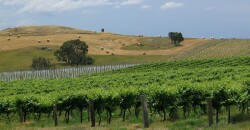
Viticulture |
Victoria’s changing climate
Mean annual temperature (two scenarios from past records and one predicted scenario)
1970-1995 | 1996-2005 | 2050 A1FI prediction |
| | |
|
1970-1995 | 1996-2005 | 2050 A1FI prediction |
| | |
|
